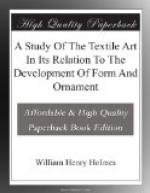We have observed throughout the series of examples presented a decided tendency toward banded or zonal arrangement of the ornamentation. Now each of these bands is made up of a number of units, uniform in shape and in size and joined or linked together in various suitable and consistent ways. In contemplating them we are led to inquire into the nature of the forces concerned in the accomplishment of such results. The question arises as to exactly how much of the segregating and aggregating forces or tendencies belongs to the technique of the art and how much to the direct esthetic supervision of the human agent, questions as to ideographic influence being for the present omitted. This is a difficult problem to deal with, and I shall not attempt more here than to point out the apparent teachings of the examples studied.
The desires of the mind constitute the motive power, the force that gives rise to all progress in art; the appreciation of beauty and the desire to increase it are the cause of all progress in purely decorative elaboration. It appears, however, that there is in the mind no preconceived idea of what that elaboration should be. The mind is a growing thing and is led forward along the pathways laid out by environment. Seeking in art gratification of an esthetic kind it follows the lead of technique along the channels opened by such of the useful arts as offer suggestions of embellishment. The results reached vary with the arts and are important in proportion to the facilities furnished by the arts. As I have already amply shown, the textile art possesses vast advantages over all other arts in this respect, as it is first in the field, of widest application, full of suggestions of embellishment, and inexorably fixed in its methods of expression. The mind in its primitive, mobile condition is as clay in the grasp of technique.
A close analysis of the forces and the influences inherent in the art will be instructive. For the sake of simplicity I exclude from consideration all but purely mechanical or non-ideographic elements. It will be observed that order, uniformity, symmetry, are among the first lessons of the textile art. From the very beginning the workman finds it necessary to direct his attention to these considerations in the preparation of his material as well as in the building of his utensils. If parts employed in construction are multiple they must be uniform, and to reach definite results (presupposing always a demand for such results), either in form or ornament, there must be a constant counting of numbers and adjusting to spaces. The most fundamental and constant elements embodied in textile art and available for the expression of embellishment are the minute steps of the intersections or bindings; the most necessary and constant combination of these elements is in continuous lines or in rows of isolated figures; the most necessary and constant directions for these combinations are with the web and the woof,




